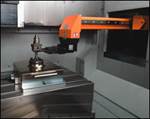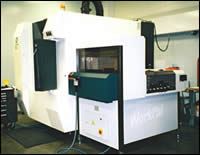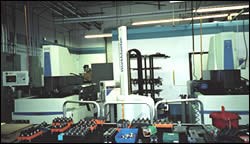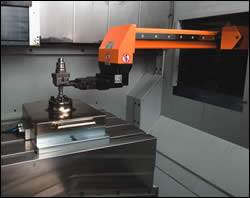Automation Is the Bridge Between EDM and Precision Mold Manufacture
The automation route has three key milestones: (1) tooling, (2) palletization and (3) robots, all of which should neatly slot into each other and help govern the speed of change.
The increasing pressures from both domestic and especially global competitors in lower-cost econo-mies, have motivated leading U.S. moldmakers to change the way that they think and work. They have realized that they need to work smarter by obtaining greater manufacturing efficiencies, reducing costs and improving productivity. This achievable improvement of the bottom line has enabled them to not only survive but grow. And, to vitally secure the future jobs of their labor force.
The Automation Route
Automation has been the golden key to unlocking the potential in their businesses by meeting these objectives. Moving from their more traditional manufacturing operations has not only been a major investment by these companies in dollar terms, but has also necessitated major shifts in mind-set by both management and employees. Automate or die has become the rallying call for moldmakers nationwide and there is no doubt that the sooner companies take the automation route the better.
Embracing an automation concept early on has proved to be the best solution to deal with global manufacturing issues for moldmakers’ customers. The advantages of unattended lights-out production together with improved productivity have seen a rapid turn-round in their fortunes. Automation reduces machine downtime and extends the working week and machine utilization without having to take on any extra labor. The increasing demands from customers who operate in the JIT environment are more comfortably served with substantial gains in speed of delivery. Optimum 24/7 working is the ultimate destination at the end of the automation route.
Most companies will therefore introduce automation in a planned program that not only utilizes the existing plant in the shop; and, therefore may be the line of least cost, but also takes into account the skill levels and current working practices of their labor force.
This automation route has three key milestones: (1) tooling, (2) palletization and (3) robots, all of which should neatly slot into each other and help govern the speed of change.
Tooling
Standardizing on one tooling system throughout the shop has very clear advantages. Primarily it allows moldmakers to transfer workpieces or electrodes from one process to another—from EDM to high-speed machining, for example—with-out any loss of positioning or accuracy.
With high technology industries such as aerospace, medical devices and communications demanding very strict tolerances, it is vital to select a tooling system that guarantees repeatable accuracy down to around +0.0001inch (+0.002 mm).
Thus each machine in the shop, fitted with a compatible chuck on the spindle or the table, easily accepts the tooling and operates assuredly, delivering pre-set accuracy without having to re-check measurements.
Using such tooling with a stable and accurate reference system not only increases the labor force’s confidence in relying on its accuracy, but also takes some of the tedium out of setting-up. Setting-up times are minimized and because the reference system is compatible with every machine in the shop, the road to full automation starts to be seen as a reality.
An initial experience of the benefits of automation can also be a useful interim step, where automatic toolchangers can, for example, be retrofitted to an existing machine, thus increasing its overall productivity and efficiency.
Palletization
Viewing toolholders as mini pallets takes us on to the next milestone along the automation route—palletization. The initial selection of a standardized, fully-compatible tooling system needs to take into account the requirement to scale-up. It needs to be one that can be built-up as requirements demand, without having to reinvent the wheel.
So, flexibility is the key in ensuring different sizes and weight of electrode or workpiece can be accommodated within the same system. These parameters could range from 1 to 18 inches (30-400mm) square and from a few ounces to over 1,000 pounds (0.5–500 kg). There are also larger pallet systems available with greater capacities (up to 10 metric tons) where the limiting factor is only the size of the machine table.
Palletization allows semi-skilled labor in the shop to set up work outside the machines while they continue to run. This not only gives flexibility for mix and match production, but also allows for the emergency situation where a workpiece needs to be machined quickly.
Precision workholding through assured palletization protects the dimensional accuracy and integrity of every part and production runs can be interrupted if need be.
The same degree of labor involvement is still unavoidable at this stage, even if pallet changers are part of a production cell.
However, faced with an increasing shortage of skilled craftsmen there are still pressures to take out as much labor content from the production process as possible and that is where the final leg on the automation route is reached.
Robots
Total automation systems are a combination of tooling, palletization, robots and an overriding software system that manages workflow and programs the production cells. It is important to choose a supplier that can offer you a range of robot options—both immediate and for the future—depending on your own business plans and investment program.
The introduction of robots into any shop could be seen as a threat to the labor force—one automated shop reports 22 machines being operated by one employee around the clock! However, management should ensure that this step is seen as an opportunity to become more efficient, more competitive, and above all, to protect jobs.
Putting Automation into Practice
One such creative-thinking mold-maker, in the business for more than 30 years, is Peter McGillivray of Dynamic Engineering (Minneapolis, MN). “We had a number of meetings and at one I gave everyone a copy of ‘Who Moved My Cheese?’ by Spencer Johnson. This book is all about dealing with change and enjoying more success. It helped communicate the points we needed to impress on the team, to instil confidence and to focus everyone on the positive steps that were planned to secure the future of the company.”
The more machines that any robot can interface with the better, and suppliers that have a successful track record in developing open architecture systems should ideally be sought.
No two shops are the same and the ability to integrate robots into almost any manufacturing cell is a must. It is no accident that many of the world’s leading OEMs work with such suppliers to integrate their robots in order to enhance the productivity of their own machines.
Depending on the size of the shop and existing machines it is also critical to select a supplier with a range of robots—of varying sizes, capacities and capabilities—that can be incorporated as the moldmaker grows.
Robots could be tasked to serve one, two or even three machines and even interface with a CMM. It could be an all sinker EDM cell, an all milling cell, a milling/grinding cell or an EDM/milling cell—such combinations will be unique to each shop. That is where the skill at developing software to allow the machines to talk to each other comes to the fore.
An understanding of the moldmaking industry and the range of machines it uses, gained through many years of association with it, together with an in-house software development team is the optimum combination most likely to be able to deliver a user-friendly, state-of-the-art system that works. Access online at all times to the entire production process becomes a reality, especially if integration with a shop’s own MPS systems is achievable.
Auto-ID systems on pallets also ensure the highly efficient capability of coping with chaotic loading of workpieces via the managing software system, from magazines (carousels or bookcases) that may contain up to 1,500 individual tools and/or workpieces.
Automatic loading of cells delivers true 24/7 working and remote monitoring by webcams, if need be, is a luxury to be enjoyed.
Take the Automation Route with Confidence
Embracing leading-edge technology can say volumes about your business, especially as many of your customers or potential customers are likely to be technology leaders themselves. How you decide to take the route is, of course, up to each individual company, but those that have, have no regrets.
One significant benchmark has been comparing the revenue generated per employee before and after installing automation in the shop. Using traditional work practices the automated shops have increased their revenue by 18 to 24 percent!
“We jumped in with both feet and spent more than $3 million on robots, tooling and palletization, plus other cutting-edge machines,” says Patrick Elliott, President of JK Molds (Upland, CA). “It was invest or die! Armed with our automated cells we are targeting $8 million sales with our core team of only 30—an amazing turnaround when you consider that the industry yardstick is around $ 150,000 per employee!”
It is this added-value per employee that is the key to future prosperity for moldmakers that take this journey.
“Automation has allowed us to be more productive while taking out as much labor content from our production processes as possible. Productivity gains have increased our value-added employee output. We continue to be positioned in the top 10 percent of employee productivity ratios as published by the National Tooling and Machining Association,” explains Dynamic Engineering’s McGillivray.
24/7 lights-out production has equated to lights-on progress for many moldmakers in the U.S. and there is no doubt that automation is the bridge between EDM and precision moldmaking.
Related Content
It Starts With the Part: A Plastic Part Checklist Ensures Good Mold Design
All successful mold build projects start with examining the part to be molded to ensure it is moldable and will meet the customers' production objectives.
Read More6 Ways to Optimize High-Feed Milling
High-feed milling can significantly outweigh potential reliability challenges. Consider these six strategies in order to make high-feed milling successful for your business.
Read MoreMoldmakers Deserve a Total Production Solution
Stability, spindle speed and software are essential consideration for your moldmaking machine tool.
Read MoreRead Next
Automation and Moldmaking: Mold Production in Action
Moldmakers are starting to change the way they think and incorporate automation into all aspects of their operation—combining a multitude of processes in a single cell for optimal productivity.
Read MoreHow to Use Strategic Planning Tools, Data to Manage the Human Side of Business
Q&A with Marion Wells, MMT EAB member and founder of Human Asset Management.
Read MoreAre You a Moldmaker Considering 3D Printing? Consider the 3D Printing Workshop at NPE2024
Presentations will cover 3D printing for mold tooling, material innovation, product development, bridge production and full-scale, high-volume additive manufacturing.
Read More






















